 The worker-bee has a complex pectoral apparatus that is under the last abdominal ring. This device consists of so-called sled, two stylet, three pairs of chitinous plates (oblong, triangular, square) and two poisonous glands (large and small). The stylet is a thin needle-like chitin wand with 10 notches at the end.
The worker-bee has a complex pectoral apparatus that is under the last abdominal ring. This device consists of so-called sled, two stylet, three pairs of chitinous plates (oblong, triangular, square) and two poisonous glands (large and small). The stylet is a thin needle-like chitin wand with 10 notches at the end.
When stung, the stylet extends beyond the sled and sticks into the skin, and the poison glands are connected to the sled of the sting. The large poisonous gland (with a strong acid secret) consists of a long thread-like tube starting with a fork and ending with an enlarged part – a reservoir of the poisonous gland. In the filamentous part of the large poisonous gland, a poison is produced, which comes before it is stung into the tank-poisonous vial. A small poisonous gland (with a slightly alkaline secret) is a short tube opening at the base of the sled.
Bee venom drains into the wound on the groove on the lower surface of the sled. When stung, the stethoscope opens, and as a result of the autonomic muscle contractions of the stiletto, the stinger penetrates deeper into the skin of the skin.
A bee that has aroused a man loses its sting and after a while dies; when the bee attempts to pull its sting out of the elastic human skin it breaks off, since it is provided with the finest, inverted burrs, stuck in the skin. A bee stung by another bee or some insect (and this is the natural purpose of its poisonous weapons), does not lose its sting and does not suffer any damage at all. Only in the event that a bee stings a person or animal, it pays for it with life.
Лечебный напиток с медом. Люцерна мед.
Bee venom